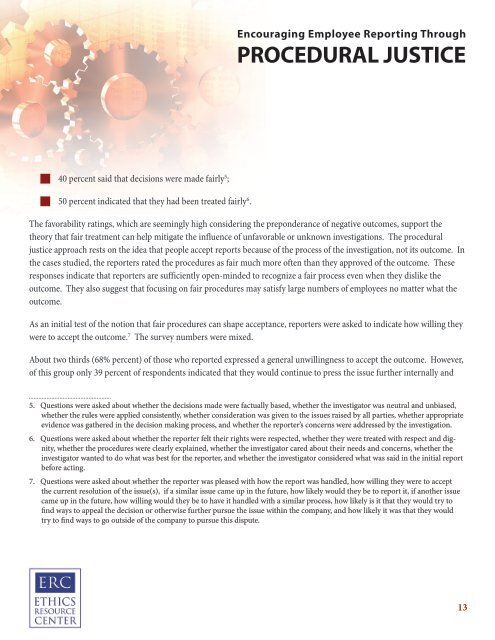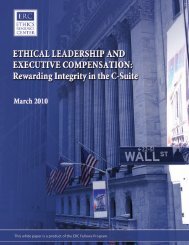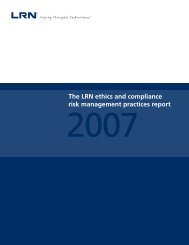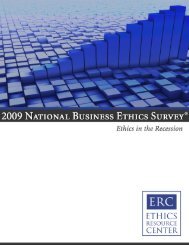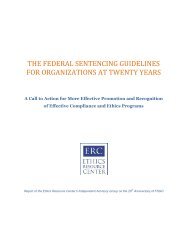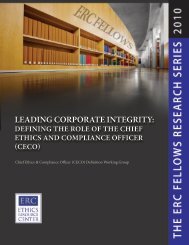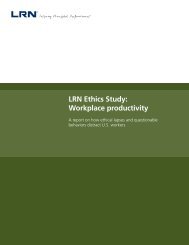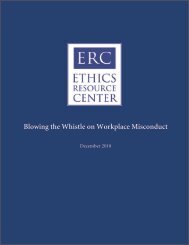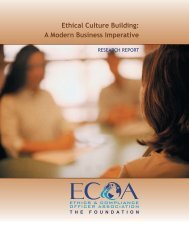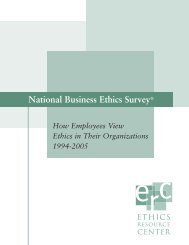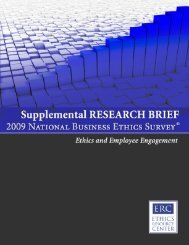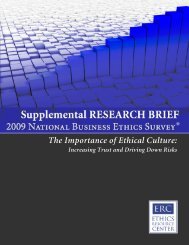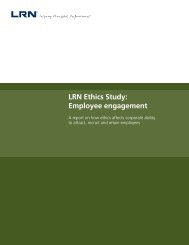PROCEDURAL JUSTICE - Ethics Resource Center
PROCEDURAL JUSTICE - Ethics Resource Center
PROCEDURAL JUSTICE - Ethics Resource Center
You also want an ePaper? Increase the reach of your titles
YUMPU automatically turns print PDFs into web optimized ePapers that Google loves.
Encouraging Employee Reporting Through<br />
<strong>PROCEDURAL</strong> <strong>JUSTICE</strong><br />
JJ<br />
40 percent said that decisions were made fairly 5 ;<br />
JJ<br />
50 percent indicated that they had been treated fairly 6 .<br />
The favorability ratings, which are seemingly high considering the preponderance of negative outcomes, support the<br />
theory that fair treatment can help mitigate the influence of unfavorable or unknown investigations. The procedural<br />
justice approach rests on the idea that people accept reports because of the process of the investigation, not its outcome. In<br />
the cases studied, the reporters rated the procedures as fair much more often than they approved of the outcome. These<br />
responses indicate that reporters are sufficiently open-minded to recognize a fair process even when they dislike the<br />
outcome. They also suggest that focusing on fair procedures may satisfy large numbers of employees no matter what the<br />
outcome.<br />
As an initial test of the notion that fair procedures can shape acceptance, reporters were asked to indicate how willing they<br />
were to accept the outcome. 7 The survey numbers were mixed.<br />
About two thirds (68% percent) of those who reported expressed a general unwillingness to accept the outcome. However,<br />
of this group only 39 percent of respondents indicated that they would continue to press the issue further internally and<br />
5. Questions were asked about whether the decisions made were factually based, whether the investigator was neutral and unbiased,<br />
whether the rules were applied consistently, whether consideration was given to the issues raised by all parties, whether appropriate<br />
evidence was gathered in the decision making process, and whether the reporter’s concerns were addressed by the investigation.<br />
6. Questions were asked about whether the reporter felt their rights were respected, whether they were treated with respect and dignity,<br />
whether the procedures were clearly explained, whether the investigator cared about their needs and concerns, whether the<br />
investigator wanted to do what was best for the reporter, and whether the investigator considered what was said in the initial report<br />
before acting.<br />
7. Questions were asked about whether the reporter was pleased with how the report was handled, how willing they were to accept<br />
the current resolution of the issue(s), if a similar issue came up in the future, how likely would they be to report it, if another issue<br />
came up in the future, how willing would they be to have it handled with a similar process, how likely is it that they would try to<br />
find ways to appeal the decision or otherwise further pursue the issue within the company, and how likely it was that they would<br />
try to find ways to go outside of the company to pursue this dispute.<br />
13


